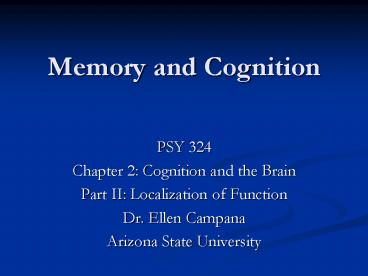Memory and Cognition PowerPoint PPT Presentation
1 / 25
Title: Memory and Cognition
1
Memory and Cognition
- PSY 324
- Chapter 2 Cognition and the Brain
- Part II Localization of Function
- Dr. Ellen Campana
- Arizona State University
2
The Whole Brain
- Localization of function - Different parts of the
brain serve different functions - Many, many ways to divide the brain
- Like an onion, many layers
- Like a fractal, the closer you look the more
complex it seems - Descriptions may seem contradictory and/or
overlapping because of this
3
Cerebral Cortex
- Most important for Cognition
4
Cerebral Cortex
- Temporal Lobe
- Language
- Memory
- Hearing
- Perceiving forms
- Occipital Lobe
- Visual information (early processing) feature
detectors
5
Cerebral Cortex
- Parietal Lobe
- Touch
- Vision
- Attention
- Frontal Lobe
- Proportionately larger in humans than in other
species - Language
- Thought
- Memory
- Motor functioning
6
Subcortical Structures
7
Subcortical Structures
- Hippocampus
- Forming memories
- Amygdala
- Emotions, emotional memories
- Thalamus
- Processing sensory information (vision, hearing,
touch)
8
Hemispheres
- Brain separated into sides (hemispheres)
- Corpus Collosum connects them
- Structurally and functionally very similar
- Lateralization specific functions occurring in
one hemisphere or the other
Note Sperry studied split-brain patients, who
had had their corpus collosum severed as a
treatment for epilepsy. He shared Hubel
Weisels Nobel Prize for this work.
9
Lateralization
- Vision of left part of the world lateralized to
the right side (opposite also true) - Motor Control of left side of body lateralized to
the right side (opposite also true) - Touch on left side of body lateralized to the
right side (opposite also true)
10
Lateralization
- Are there right-brained and left-brained
people? - Analytical/Logical processing (syntax of
language) usually on the left side (not always) - Analogy and Broad Thinking usually on the right
side (not always) - Everyone has (and uses) both
- Patients who have had a hemispherectomy
- Other side usually takes over missing
functionality - Coglab Brain Assymetry
11
Localized Function
- Parietal Lobe
- Sensory Homunculus (near the front, somatosensory
cortex) - Motor Homunculus (near the back, motor cortex)
12
Sensory Homunculus
Each side of the brain has a copy, which
processes touch from the other side
13
Localized Function
- Parietal Lobe
- Sensory Homunculus (near the front, somatosensory
cortex) - Motor Homunculus (near the back, motor cortex)
- Temporal Lobe
- Wernickes Area metaphor, meaning in language
- Brocas Area logical structure of language
- Fusiform Face Area (FFA) specialized for faces
(or is it things were experts at recognizing???)
14
Researching Localized Function
- Neuropsychology comparing patients with
localized brain damage - Single dissociation single patient has some
things impaired, other things not impaired
15
Single Dissociation Phineas Gage
- Construction accident 1848
- Harlow (doctor) wrote a lot about his condition
- Gage lived, could talk, act, and do all normal
activities, but suffered impairment of emotional,
social, and personal traits - Evidence for some separation of language and
social traits, etc.
16
Researching Localized Function
- Neuropsychology comparing patients with
localized brain damage - Single dissociation single patient has some
things impaired, other things not impaired - Brocas Aphasics, Wernickes aphasics,
Prosopagnosiacs - Double dissociation -- two (or more) patients
show opposite single impairments - Brocas Wernickes Aphasics considered together
17
Double Dissociation
Form The boy was pushed by the girl Meaning The apple was eaten by the girl
Brocas Aphasics Impaired OK
Wernikes Aphasics OK Impaired
18
What can we conclude?
- Double dissociation
- Two functions involve different mechanisms
- Two functions involve different brain areas
- Mechanisms are independent
- Single dissociation
- Two functions involve different mechanisms
- Two functions involve different brain areas
- Mechanisms may not be independent
19
Limitations of Neuropsychology
- At least for human processing, brain damage comes
about from natural means (accident, etc.) - Members of groups rarely have exactly the same
damage (location or extent) - No record of processing or brain organization
before the damage - Difficult to assess all possible types of
functional impairment - Brain may actually reorganize following damage
(called plasticity)
20
Imaging Methods
- EEG- Electrodes on outside of head continuously
measure electrical activity - PET- Radioactive dye injected, accumulates in
different regions over time and can be read by a
scanner. Essentially measures metabolism of
neurons - fMRI- Brief magnetic pulses used to give a
snapshot of ratio of oxygenated to deoxygenated
blood (metabolism) - TMS- New measure. Magnetic field can disable
specific portions of the brain for a short time,
simulating damage. - Temporal resolution Detail with respect to time
- Spatial Resolution Detail with respect to
physiology
21
Image from an fMRI scan
Image from a PET scan
22
Imaging Methods
Spatial Resolution Temporal Resolution
EEG Poor Good
PET Excellent Poor
fMRI Good Good
TMS Good Good
23
Subtraction Technique
Visual Stimulus (light flashing)
Visual Stimulus (light flashing)
- Used for fMRI studies
- Method similar to Donders study
- Compared two situations that included different
cognitive processes - Data blood glucose level
- Relative measure
Perception of the light
Perception of the light
DECISION
Response
Response
24
Subtraction Technique
- Activation in control condition is subtracted
from experimental condition to get activity due
to stimulation in the experimental condition
25
The End
- Next up Representation in the Brain

